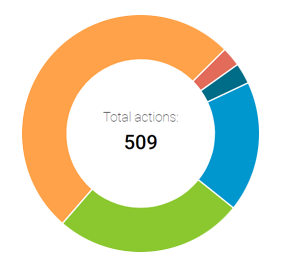How wonderfully luxurious is cruise control? Pick a number, press a button, and done. Simple, convenient, and enables us to travel while avoiding detection from the State Highway Patrol.
Just set it and forget it!
While this may be appropriate for our ventures on I-90 or the Northway, it couldn’t be more inappropriate for your business as it navigates the world of digital marketing.
Just setting it and forgetting it with your marketing may be simple and convenient, like programming the cruise control on your SUV, but the last thing you want in business is to avoid detection. And by implementing this passive strategy, that's precisely what you’ll do.
In this blog, we're going to help you understand what “set it and forget it” marketing is and why it will hurt your business. We'll also will give you a look at the active, growth-driven strategy we use for our clients and why it works much better.
A note before we get started: while "set it and forget it" marketing is used in all mediums (such as the same radio/tv commercial that plays 24/7/365, or the static billboard that's been up for years, or the unchanging print ad in the local paper), we'll only be discussing Google Ads in this article. Google Ads is the world's largest and most popular PPC advertising platform. It’s so widely used, it has become synonymous with the term “paid search.”
It's also where the crime of "set it and forget" occurs most often in digital marketing.

What is the "Set It and Forget It" Method?
Imagine you’re a rock star wunderkind who has invented a pair of spectacles that give the wearer the ability to see if someone is lying to you. It's a billion-dollar powder keg waiting to explode. But there's one issue: people need to discover it.
You meet with a digital marketing agency who wisely (and obviously) suggests a Google Ad campaign. You concur and sign a year-long contract. They tell you about keywords, headlines, descriptions, click-through rates, impressions, etc., and throw around enough jargon to confuse the hell out of you and make you defer to their "expertise." They tell you no worries, just sit back, relax, and watch customers flock like the Salmon of Capistrano.
A few days goes by and your site gets a few hundred hits. But after a few weeks, the numbers gradually decline until... crickets. Next thing you know, you’re five or six months into your year-long contract and your brand awareness is no better than it was before. Nothing has changed.
You know what else hasn't changed? Your Google Ads campaign. This is "set it and forget it."
In a lot fewer words — it’s creating a campaign, launching it, and not doing a thing with it after the initial launch. Your ads end up costing you more than they should and you reach less people. What a deal, right?
Why "Set It and Forget It" Ultimately Fails Your Business
A while back, we read an article where the author compared creating a Google Ads campaign to writing a first draft. First drafts are trial and error. In a draft, you release words into the atmosphere and see what works, and more importantly, what doesn’t.
Digital marketing, especially Google Ads, provide you instantaneous feedback in the form of hard numbers, showing you what is or isn't working. Traditional forms of advertising cannot provide this kind of information. After receiving enough performance data from your Google Ads, you can sit down, calibrate, and adjust accordingly. Then do it again. And again. And again. Why? Because top-performing keywords, bidding competition, and algorithms are always changing.
Some may find this tedious, and would rather just do it once and be done with it — but their ads will perform poorly because they're only a first, rough draft. Those who successfully use Google Ads see revisions for what they are — opportunities to continually improve.
We can’t begin to tell you how many times we bring in new clients, do an audit of their previous and/or current campaigns, and see there have been no changes made to their Google Ads campaigns since they were launched.
If the client previously managed the ads themselves and had no prior experience with PPC marketing, it's understandable. If another agency was paid to set it up and then did nothing to make it successful, that makes us really, really mad.
We work in marketing because we want to help businesses succeed. We believe effective advertising has the power to help entrepreneurs' dreams become reality. Because of that, we’re proponents of transparency. We're open with our clients about our processes, procedures, and the reasoning behind them. Why? Because we believe when they become our client, it's our job to help them navigate the treacherous yet prosperous seas of marketing.
So what's the alternative to the lazy, "set it and forget it" approach? Active, growth-driven marketing that relies on data and continually evolves.

The 6 Stages of Successful Marketing
Marketing your business is less like a highway and more like a hilly and winding road — and it requires and deserves your (or your agency's) full attention. And by full attention, we mean careful planning and setup, followed by continuous analysis and improvement. Your business deserves more than cruise control.
1. Identify
Earlier we mentioned that the first thing we do is audit a client's previous and current campaigns. This is the "identify" stage, when we sit down and discuss what you’ve done in the past, as well as your goals, expectations, and any immediate opportunities we can assist with.
2. Fix
Inevitably, we'll find things that can be improved or fixed in your ads, on your landing pages, on your website, etc. We want to ensure you are appropriately positioned before you invest any advertising dollars into a campaign that would drive people to these potential trouble areas.
3. Plan
Our plans are always based on your goals. We create a detailed plan ahead of time so we can approach your advertising in a deliberate and strategic way. What different campaigns will we run? What landing pages will we need? What does your current competition look like? What are the objectives? All these questions and more are taken into consideration when we create a plan.
4. Build & Execute
We then build your campaigns in Google Ads and ensure that everything is set up well from the start.
5. Monitor & Measure
We do exactly what it sounds like — we actively monitor the performance of your ads and measure it against our mutual expectations.
6. Real-Time Adjustments
This is the most important difference between the "set it and forget it" method and the approach we use. We take the data from monitoring and measuring, assess your ads, and adjust accordingly. And we do this on a regular, continuous basis. This requires time, creativity, logic, and effort. While some may call this tedious, this is what we love to do — taking something and making it better.
The Process in Action
See the chart above? It reflects the actions (or adjustments) we made to a client's Google Ads back in December 2018. We made 509 edits to their ads. The result? Our efforts delivered 60.52% more qualified leads for our client but only spent half as much on advertising as they had before. Previously, their Google Ads hadn't been revised in over six months.
In Conclusion: Cruise Control Will Run Your Ad Campaign into a Wall Faster than a Crash Test Dummy
To be fair, there are always a handful of exceptions to the rule and some very lucky businesses have been able to use a "set it and forget it" strategy successfully. But almost everyone who takes a passive approach to Google Ads is wasting valuable advertising dollars.
Look at it this way: would you ever want to run your business on cruise control? Of course not. Then why would you allow it to be marketed that way? Remember what we said earlier:
Marketing your business is less like a highway and more like a hilly and winding road — and it requires and deserves your (or your agency's) full attention.
If you're wondering if your business has signed a “set it and forget it” contract with another agency, contact SIX today and we’ll take a look at it for free and give you our honest opinion. We can tell you within a few minutes if your current strategy is worth the investment, and we're only a phone call, email, or chatbot message away.
Cheers,
Team SIX
[Editor's note: This article was originally published on January 12, 2019 and updated on January 4, 2022.]




